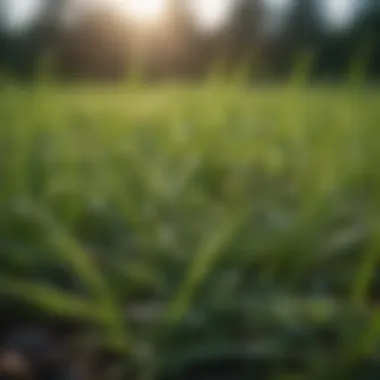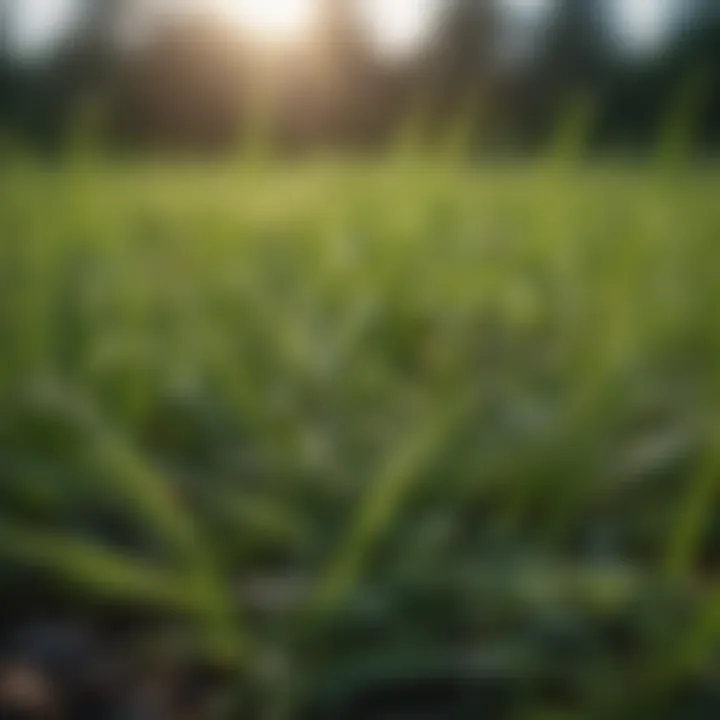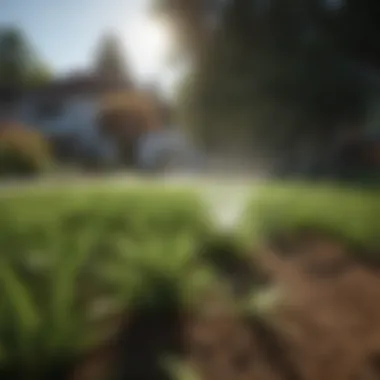Watering Grass: Daylight Impacts and Best Practices


Intro
Watering grass, especially during the heat of the day, raises many questions among homeowners and gardening enthusiasts. It may appear harmless at first glance, but several factors come into play when considering the timing of this routine lawn care activity. The core of the issue revolves around evaporation rates, nutrient distribution, and the overall health of your grass. In this article, we’ll navigate the often murky waters of grass irrigation practices, shedding light on the best approaches while factoring in ecological implications.
As the sun climbs high, it impacts not just our ability to enjoy the outdoors, but also how efficiently we can tend to our lawns. When watering happens mid-day, a significant portion of that precious water might evaporate before it even quenches the roots of your grass. Understanding these nuances will help not only in maintaining a lush lawn but also in being a responsible steward of available resources.
"Watering during peak sunlight can lead to waste—both water and dollars."
Each section ahead will break down complex considerations into digestible pieces, so by the end, you'll be armed with knowledge that not only enhances your gardening skills but aligns with a sustainable outlook.
Understanding the Necessity of Grass Watering
Grass, much like any living organism, thrives with adequate moisture. This makes the act of watering essential, especially in regions where rainfall might play hard to get. Not all homeowners realize that the art of nurturing grass goes beyond just slapping water on the blades. It’s a full-blown interaction with nature, requiring awareness of various factors that can affect lawn health.
Water is fundamental for grass health. It serves as the vehicle through which nutrients are absorbed from the soil, making it critical for growth. Without the right amounts, grass can develop all sorts of issues, such as discoloration or wilting. It’s often said that a lush lawn can be the crowning glory of any yard, serving not just as an aesthetic pleasure but also as a functional area for recreation.
"A vividly green lawn has a way of adding the finishing touch to a home, making it feel like a sanctuary amid the hustle and bustle of life."
Additionally, understanding when and how much water to apply can prevent unnecessary strain on local water supplies. In the grand scheme of things, taking time to learn about proper watering regimes can lead to significant savings not just in costs but also in protecting essential resources. Thus, homeowners engaging in this practice are actually participating in more sustainable living.
The Role of Water in Grass Health
Water doesn’t just keep the grass alive; it actively contributes to its vibrancy. The way in which grass utilizes water can be broken down into a few essential aspects:
- Nutrient Transport: Water carries essential nutrients from the soil to the grass roots. Without it, grass becomes starved of the very elements needed for growth like nitrogen, phosphorus, and potassium.
- Cellular Integrity: Just like how humans need to stay hydrated, grass relies on water to maintain its turgidity, which keeps it upright and resilient against the elements. A parched lawn is akin to a wilted flower – droopy and lifeless.
- Photosynthesis Efficiency: Grass needs water to facilitate photosynthesis. This process converts sunlight into energy, enabling the grass to grow. Too little water, and you’ll find that the grass is not just struggling but struggling to thrive.
In essence, failing to provide this vital resource can lead to a rather unhappy lawn, one that cannot meet its potential. It’s the difference between just having grass and having a thriving green tapestry.
Factors Influencing Grass Growth
The health of grass is dictated not just by water but by an array of factors working hand-in-hand. Here are a few that every homeowner should keep in mind:
- Soil Quality: The nutrient content and pH level of the soil can significantly influence how well grass grows. Quality soil retains moisture better and offers essential nutrients conducive to growth.
- Climate Conditions: Different climates require different care strategies. A sunny part might need more watering compared to a shaded area. Knowing how sunlight affects your lawn is key.
- Grass Type: Not all grasses are equal. Cool-season grasses, like fescue, generally require different watering schedules compared to warm-season species such as Bermuda. Homeowners should consider what kind they have before developing their watering routine.
- Foot Traffic: Heavy traffic can compact soil, making it difficult for the grass roots to access necessary water and nutrients. In high-traffic areas, more care might be needed to ensure that the grass remains healthy.
In summary, the necessity of grass watering is nestled within a web of factors that can either promote or hinder the growth of a lush lawn. It goes beyond just filling up a hose and spraying – it’s about understanding how every element interacts with each other to sustain that vibrant greenery that we all desire.
Timing and Temperature Considerations
When you're out tending to your lawn, timing and temperature are probably not the first things on your mind. Yet, these elements can significantly sway the health and appearance of your grass. Far from being mere details, they are the bedrock of successful grass watering practices.
Watering during specific parts of the day can optimize the moisture absorbed by grass. Also, understanding how temperature impacts both water efficacy and evaporation can lead to better choices, resulting in a lush and thriving lawn. Let’s dissect these aspects further.
Daytime Watering: Pros and Cons
Watering grass during daylight hours carries its own palette of advantages and disadvantages. On the plus side, watering in the day can cater to immediate hydration needs. If the sun is blazing down, your grass can quickly get thirsty, and providing a drink during peak hours ensures it doesn't get parched. Yet, along with the benefits comes the shadow of some pitfalls.
- Pros:
- Cons:
- Immediate hydration helps grass cope during hot spells.
- Convenient for homeowners who may not have morning or evening time available.
- High evaporation rates can waste water, especially in hotter climates.
- Risk of fungal diseases due to excess moisture sitting on grass blades during warm afternoons.
Ultimately, the decision to water during the day should stem from an awareness of these factors, and savvy lawn owners will weigh the balance between their scheduling needs and the health of their grass.


Ideal Temperature Ranges for Grass Watering
It’s not just about when you water; it’s also about how warm or cool it is when you do so. Different types of grass thrive at various temperatures, affecting how they utilize water.
Generally, the ideal temperature range for watering grass falls between 55°F and 75°F (13°C to 24°C). During this temperature window:
- Grass absorbs water most effectively.
- Lower evaporation rates preserve moisture for longer durations.
As temperatures soar above 85°F (29°C), water can evaporate swiftly, leaving your grass as thirsty as before. And when temperatures dip too low, grass growth slows, which means watering becomes less effective. It’s like trying to hydrate a sloth — not quite as productive.
Impact of Sunlight on Water Evaporation
Sunlight in and of itself can be a mixed bag in the watering game. While sunlight is essential for photosynthesis and sustaining your grass’s vibrant color, it also plays a major role in water evaporation.
Under bright sunlight, especially during the warmest parts of the day, water can evaporate rapidly from the grass blades and the soil. This not only leads to wasted resources but also stresses your lawn. Think of it like filling a bucket with holes — it’ll never stay full for long.
"The sun can be a friend and a foe; what helps you thrive can also be a thief if not managed well."
To circumvent increased evaporation rates, consider watering early in the morning or late in the day. This allows your grass to drink before the sun's heat turns your efforts into thin air.
Thus, while the sun is indeed a crucial part of the landscape, knowing how to work around its heat is vital for keeping your lawn lush and healthy.
Optimal Watering Practices
When it comes to maintaining a lush and vibrant lawn, the approach you take to watering is of utmost significance. Optimizing watering processes can save water, money, and time, while also ensuring that the grass receives the hydration it needs. In this section, we will delve into effective watering techniques and the essential tools that can enhance the efficiency of lawn care.
Effective Watering Techniques
A common mistake among homeowners is to simply turn on the sprinkler system and hope for the best. However, adopting more thoughtful techniques can yield much better results. Here are several methods to consider:
- Soak, Don’t Spray: Try to water deeply but infrequently rather than shallowly but often. This encourages grass roots to grow deeper, making them more resilient to drought.
- Time It Right: The ideal time for watering is early in the morning before the sun reaches its peak. During the cooler hours, water evaporates less, allowing moisture to penetrate the soil effectively.
- Use a Watering Schedule: Keep a consistent schedule that adapts to the seasons. Just because it’s summer doesn't mean the lawn needs the same amount of water as during spring or fall.
- Avoid Watering on Windy Days: Wind can easily blow the water away from your lawns, wasting your effort.
By implementing these effective watering techniques, you not only maintain a vigorous lawn but also conserve water. Sustainable practices lead to healthier grasses and a reduced environmental footprint.
Using the Right Tools
Just as a cook needs good knives, a gardener benefits from the right tools. Effective watering demands more than just turning on a hose; the appropriate tools can dramatically impact lawn health.
- Sprinkler Systems: Consider centralized systems that allow you to control where and how much water is distributed. Automatic timers can regulate watering times, ensuring consistency.
- Soil Moisture Meters: These handy gadgets help to monitor soil moisture levels, taking the guesswork out of determining when to water. They can be particularly useful during hot spells.
- Drip Irrigation: For those with flowerbeds or specific landscaping, drip systems direct water exactly where it’s needed, minimizing evaporation and runoff.
"Investing in the right tools is like laying the groundwork for success. Without the proper instruments, the best techniques can fall flat."
Soil Condition and Grass Health
Understanding the soil condition is fundamental for healthy grass. After all, soil is the foundation on which grass grows. A common misconception is that watering alone is sufficient for maintaining a lush lawn. However, it's essential to grasp that soil quality and its moisture content play a pivotal role.
One of the primary benefits of keeping the soil moist is that it encourages deep root growth. Grass roots thrive in moist conditions, enabling them to search for nutrients and water deeper in the soil instead of remaining shallow. This not only enhances the resilience of the grass but also improves its overall health.
Moreover, adequate soil moisture aids in nutrient absorption. From nitrogen to phosphorus, these essential nutrients are vital for grass health. However, without proper soil moisture, the grass may struggle to access these nutrients, leading to thin patches and even browning. Keeping the soil appropriately watered and healthy will not only nurture the grass but also foster beneficial microorganisms. These tiny workers help to break down organic matter, enriching the soil.
"Healthy soil translates to a healthy lawn. Most problems begin beneath the surface."
Another factor is soil compaction, which can inhibit healthy growth. Heavy foot traffic or certain types of machinery can compact the soil, limiting the space available for roots to expand. This in turn can make it more difficult for moisture and air to reach the roots, which can be detrimental. Regular aeration can help combat this issue, improving the soil condition and, consequently, grass health.


It's clear how soil condition impacts grass health, thus understanding this fundamental relationship is critical for effective lawn care.
The Importance of Soil Moisture
Soil moisture acts as the lifeline for grass. Think of it as the drink of water for your lawn. Too little moisture and the grass can quickly wilt and turn brown. Too much moisture, however, can drown the roots, causing them to suffocate. Striking that perfect balance is key.
Moist soil allows for better nutrient availability. Nutrients are dissolved in water, and grass roots need this fluid to absorb essential minerals. When soil is too dry, nutrients become less accessible, stunting growth and vitality. Conversely, overly saturated soil can lead to leaching where essential nutrients wash away, leaving the grass starved.
Identifying Soil Type and Its Needs
Knowing the type of soil you have is crucial in tailoring your watering regime. Soil can generally be classified into three main types: clay, sandy, and loamy. Each of these has distinct characteristics that influence drainage, moisture retention, and nutrient availability.
- Clay Soil: This type holds moisture well but can become compacted. You'll find it challenging for water to absorb fully. If you have clay soil, consider watering less frequently but for more extended periods to enable deeper penetration.
- Sandy Soil: Great for drainage but a nightmare for moisture retention. If your yard has sandy soil, you'll need to water more often as it dries out quickly. Adding organic matter can improve its ability to hold water.
- Loamy Soil: This is the ideal soil type, balancing moisture retention and drainage. If you are lucky enough to have loamy soil, regular watering combined with a good mulch layer is sufficient to maintain an excellent growing environment for your grass.
Getting familiar with your soil type can help you modify your watering practices, leading to a lush, vibrant lawn.
Ecological Considerations
Water Conservation Techniques
In a world where water scarcity looms, employing water conservation techniques in lawn care can make a meaningful difference. Homeowners are increasingly recognizing that the way they water their lawns can affect not only their gardens but the broader environment. Here are some noteworthy methods for conserving water while maintaining grass vitality:
- Rainwater Harvesting: Collecting rainwater in barrels can provide a natural source for irrigation. This technique not only reduces reliance on municipal water but also promotes the conservation of this precious resource.
- Drip Irrigation: Rather than a full sprinkler system, drip irrigation delivers water directly to the roots of the grass. This efficient watering method limits evaporation and runoff, ensuring that more water penetrates the soil.
- Mulching: Applying organic mulch can help retain soil moisture, reducing the need for frequent watering. Mulch also adds nutrients back into the soil over time as it decomposes.
Implementing these simple practices can help homeowners use water more thoughtfully and ensure that their grass remains healthy without unnecessary waste.
Impact on Local Ecosystems
Watering grass during daylight can have a ripple effect on local ecosystems. This goes beyond just having the greenest lawn on the block; several factors entwine in the broader ecological web, intertwining the health of local flora and fauna with how lawns are maintained.
- Biodiversity: A healthy lawn supports a multitude of organisms. Insects, birds, and beneficial microorganisms depend on balanced moisture levels for their survival. Over-watering or improper timing can create conditions for pests or diseases, negatively impacting these populations.
- Runoff Issues: Daytime watering, particularly in humid or hot conditions, can lead to increased evaporation and runoff. Contaminants from lawn chemicals, such as fertilizers or pest repellents, can be washed away into storm drains, harming waterways and aquatic life.
- Soil Health: Frequent watering, especially during peak sun hours, can lead to soil erosion or degradation. Maintaining grass hydration in efficiency respects the delicate balance of soil health, ensuring that ecosystems flourish.
By considering both conservation techniques and the broader implications for local ecosystems, homeowners can promote a sustainable approach to lawn care.
The ecology of grass watering highlights the necessity of a smart strategy that fosters not just our lawns, but the environment as a whole. Making informed decisions can lead to a healthier ecosystem where grass and wildlife thrive side by side.
Debunking Common Myths
In the discussion of watering grass, especially during the bright hours of the day, a number of myths tend to cloud homeowner's judgements. It's crucial to set the record straight as misconceptions can lead to poor lawn care practices and impact the overall health of your grass. Understanding what is true and what is not when it comes to watering helps to cultivate a lush, green lawn while also conserving precious water resources. This section aims to clarify these misconceptions and empower readers with facts.
Misconceptions About Daytime Watering
One common belief is that watering grass during the day causes more harm than good due to evaporation. Sure, during the sizzling afternoon heat, a portion of the water might evaporate before it penetrates the soil. However, this doesn’t mean that watering at these hours is futile. In truth, watering in the daytime can still effectively hydrate the grass and boost its resilience against the sun’s relentless rays.
Another notable myth is that you should never water your lawn if it's sunny out. While it can feel counterintuitive, it's possible to wet the grass successfully, even under the baking sun. The trick lies in how much and how often you water.
"Don’t let the sun’s glare trick you; with the right techniques, daytime watering can still benefit your lawn."
It’s also often said that watering in the middle of the day leads to burning the grass. This idea likely comes from the observation of droplets acting like magnifying glasses and causing small burn spots. However, research shows that if the lawn is well-hydrated prior to the heat of the day, this burning is minimal. The essential thing is to ensure that grass is already moist when the sun is at its peak.
To address this issue comprehensively, consider these points:
- Evaporation Rates: Yes, increase with heat, but proper irrigation systems can mitigate losses.
- Timing: Watering during the cooler parts of the day might often yield better results, but even midday watering isn't without merit.
- Frequency: Inconsistent watering can lead to shallow root systems and dry patches, so proper planning is important.


The Truth About Watering Frequency
Shifting gears, one major myth about watering frequency is that frequent light watering is better than less frequent, deep watering. In reality, grass roots thrive when they grow deep into the soil. Deep watering encourages the roots to seek moisture lower in the soil, which makes the grass more resilient during dry weeks. Thus, it's generally best to water deeply but infrequently, promoting healthier grass overall.
Also relevant is the idea that you need to water daily for a perfect lawn. This is incorrect. Most grass types only require watering every three to four days depending on the soil and climate conditions. Checking your lawn regularly can help you determine the right schedule; look for signs like wilting blades or dull color.
To summarize the facts about watering frequency:
- Deep Watering: It’s more beneficial than shallow watering. Aim for 1-1.5 inches of water per week.
- Less Frequent: This cultivates deep root systems; give your grass room to absorb moisture well.
- Observe and Adjust: It’s key to adapt watering schedules according to weather and climate changes.
Separating fact from fiction when it comes to watering your lawn can lead to improved practices. By understanding these common misconceptions and their truths, homeowners can better care for their grass and create a healthier outdoor environment.
Integration with Lawn Care Routines
When caring for your lawn, integrating watering practices into a comprehensive plan is essential. The choices you make concerning watering in daylight can drastically affect not just the aesthetic appearance but also the long-term health of your grass and soil. A well-thought lawn care routine ensures that each element works in harmony, maximizing benefits while minimizing risks.
Creating a Comprehensive Lawn Care Plan
A comprehensive lawn care plan should address several elements: soil health, grass type, and seasonal conditions. Here are some considerations for creating this plan:
- Assessing Soil Type: Knowing your soil type helps in understanding its drainage capabilities and nutrient content. Sandy soils often drain faster, requiring more frequent watering, while clay soils retain moisture, needing less.
- Choosing the Right Grass: Different grasses have varied water needs. Kentucky bluegrass and fescue may require more moisture compared to Bermuda grass, which is drought-resistant. Tailoring your watering schedule to the grass type you have can lead to healthier growth.
- Establishing a Watering Schedule: Incorporating watering into specific times of the day can impact water retention. For instance, watering early morning when temperatures are lower allows for moisture absorption before the heat of the day accelerates evaporation.
- Monitoring Weather Patterns: Keeping an eye on forecasts is crucial. If rain is expected, you might reduce your watering frequency. Get into the habit of checking weather apps, as they often provide localized insights.
- Adjusting Fertilizer Use: The intersection of fertilizer application and watering is noteworthy. If your lawn receives fertilizer and you water shortly afterward, you risk washing away nutrients before they can be absorbed.
In these practices, it’s vital to recognize that while daytime watering can still be effective, it must be part of a larger strategy.
Seasonal Adjustments in Watering Practices
As the seasons change, so do the watering needs of your lawn. During warmer months, it’s often necessary to increase frequency, while in cooler months, the grass requires less. Here’s how to adjust:
- Spring: This is a period of growth. Depending on rainfall, you may need to implement a more regular watering schedule to help the grass establish itself. Watering early in the morning is key to preventing fungal diseases.
- Summer: The heat can throw a wrench in your plans. Increase watering during peak daytime temperatures but consider adjusting for windy days, as the wind can further hasten evaporation. It’s also useful to note that watering deeply (6-8 inches) is often more beneficial than frequent shallow watering.
- Fall: As temperatures cool, grass may slow its growth. Adjust your watering frequency down, allowing deeper penetration into the soil from occasional, thorough sessions rather than frequent, light ones. This encourages deep roots, prepped for winter.
- Winter: In many regions, lawns can almost enter a dormant phase. Watering during winter months might be less necessary unless you live in a place where snow cover is inconsistent. In these cases, a light watering can help as the ground thaws.
By integrating seasonal adjustments with a detailed lawn care routine, you skimp on neither appearance nor health. It enables a balance between effective grass maintenance and resource conservation.
"A well-watered lawn is a happy lawn, but it thrives best when ingrained in a thoughtful care strategy"
Ultimately, adapting your practices to fit within the broader context of lawn care leads to sustainable growth and a lush, vibrant outdoor space.
End and Recommendations
It‘s essential to consider the key takeaways from the preceding sections:
- The timing of watering is pivotal; early morning or late afternoon remains the golden window when evaporation losses are minimized.
- Soil quality significantly impacts water absorption and retention, demanding a tailored approach based on specific soil types.
- Utilizing effective watering techniques paired with the right tools can vastly improve results, minimizing waste and maximizing impact.
- The role of local ecosystems shouldn’t be neglected. Understanding how watering practices affect regional wildlife and plant life can help achieve a healthier lawn without disrupting nature.
Summarizing Best Practices for Watering
To ensure optimal health of your grass while being mindful of the environment, keep the following best practices at the forefront of your lawn care routine:
- Water in the Early Morning or Late Evening: This minimizes evaporation, making the process more effective.
- Use Soaker Hoses or Drip Irrigation: These methods deliver water directly to the root zone, reducing surface runoff and maximizing utilization.
- Monitor Weather Conditions: Be aware of recent rain and adjust your watering schedule accordingly. Nature often provides just what's needed.
- Test Your Soil: Knowing your soil's condition can help you determine how much water is necessary and when it should be delivered.
- Incorporate Mulching: This helps retain soil moisture and minimizes the need for frequent watering.
By integrating these practices, homeowners can strike a balance between a vibrant lawn and resource conservation.
Future Considerations in Grass Maintenance
As we keep our eyes on the horizon, several trends emerge that will likely influence grass maintenance in the coming years:
- Technological Advances in Irrigation: Innovations such as smart irrigation systems that adjust watering schedules based on weather data are gaining traction. This helps in reducing water usage without sacrificing the health of your grass.
- Sustainable Practices: Encouragement towards using drought-resistant grass varieties and xeriscaping will play a significant role as climate change impacts water availability.
- Community Engagement: Involving the community in workshops on best gardening practices fosters a sense of stewardship towards local environments.
Being proactive about these considerations not only paves the way for a healthier lawn but also establishes a legacy of responsible gardening.
"In every drop of water, there is a story of life."
So, homeowners and gardening enthusiasts alike, it’s about time we take action towards nurturing our lawns wisely, ensuring they remain both beautiful and sustainable. Let this article guide you in making the right choices, safeguarding your environment while enjoying the lush greenery that brings joy to everyday life.



